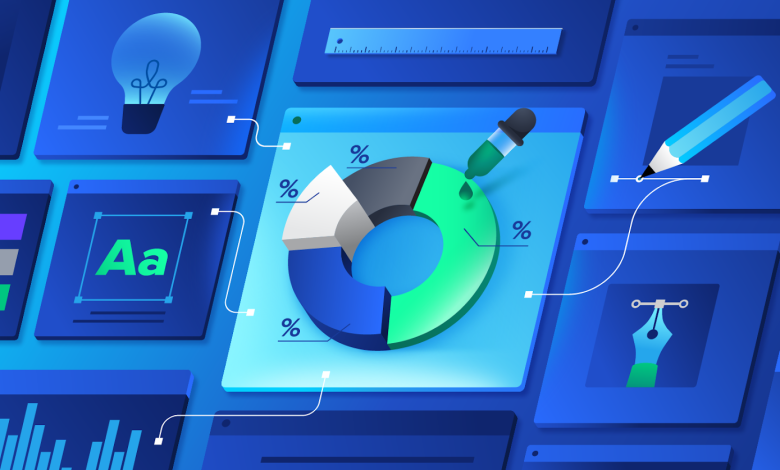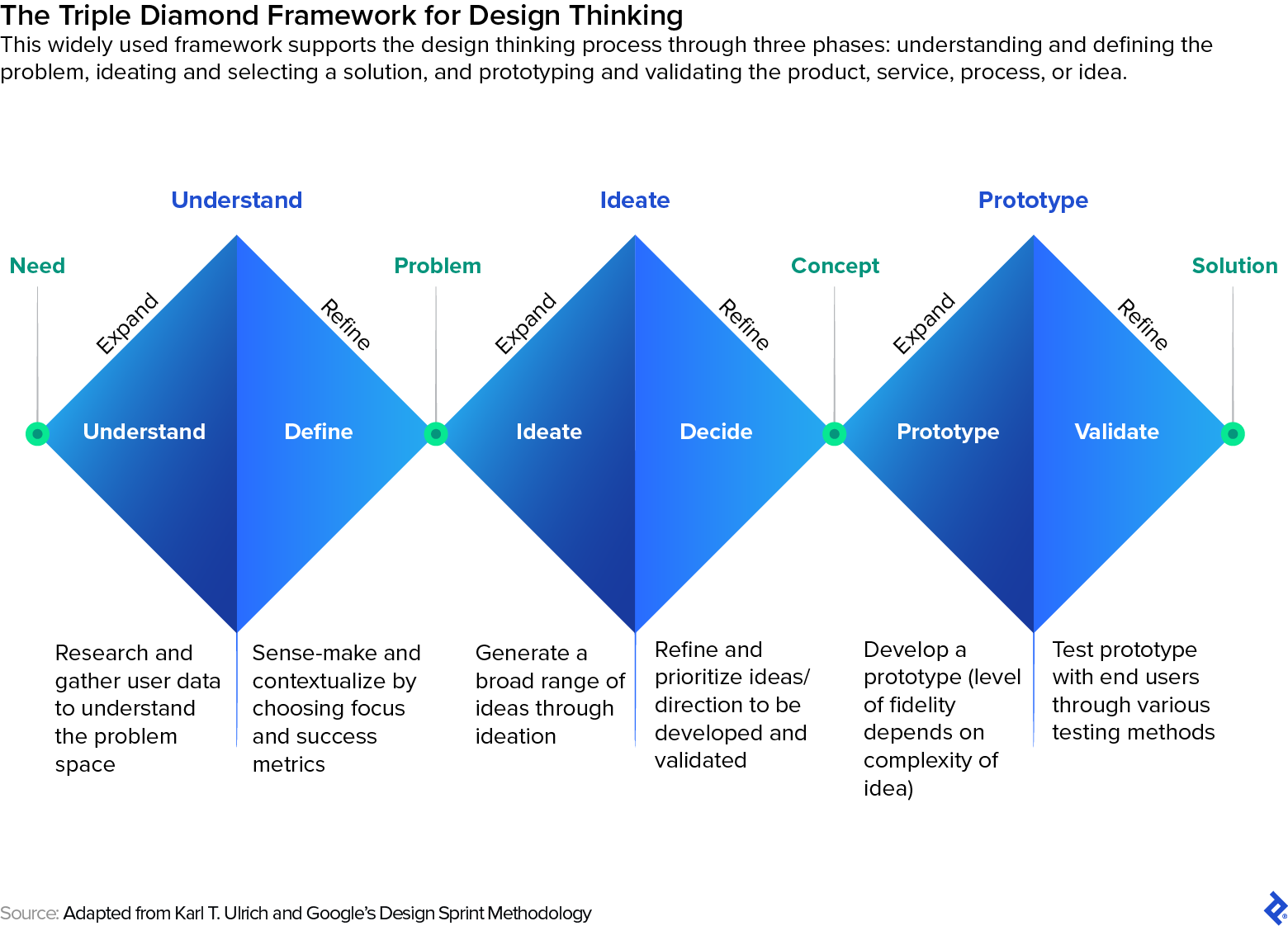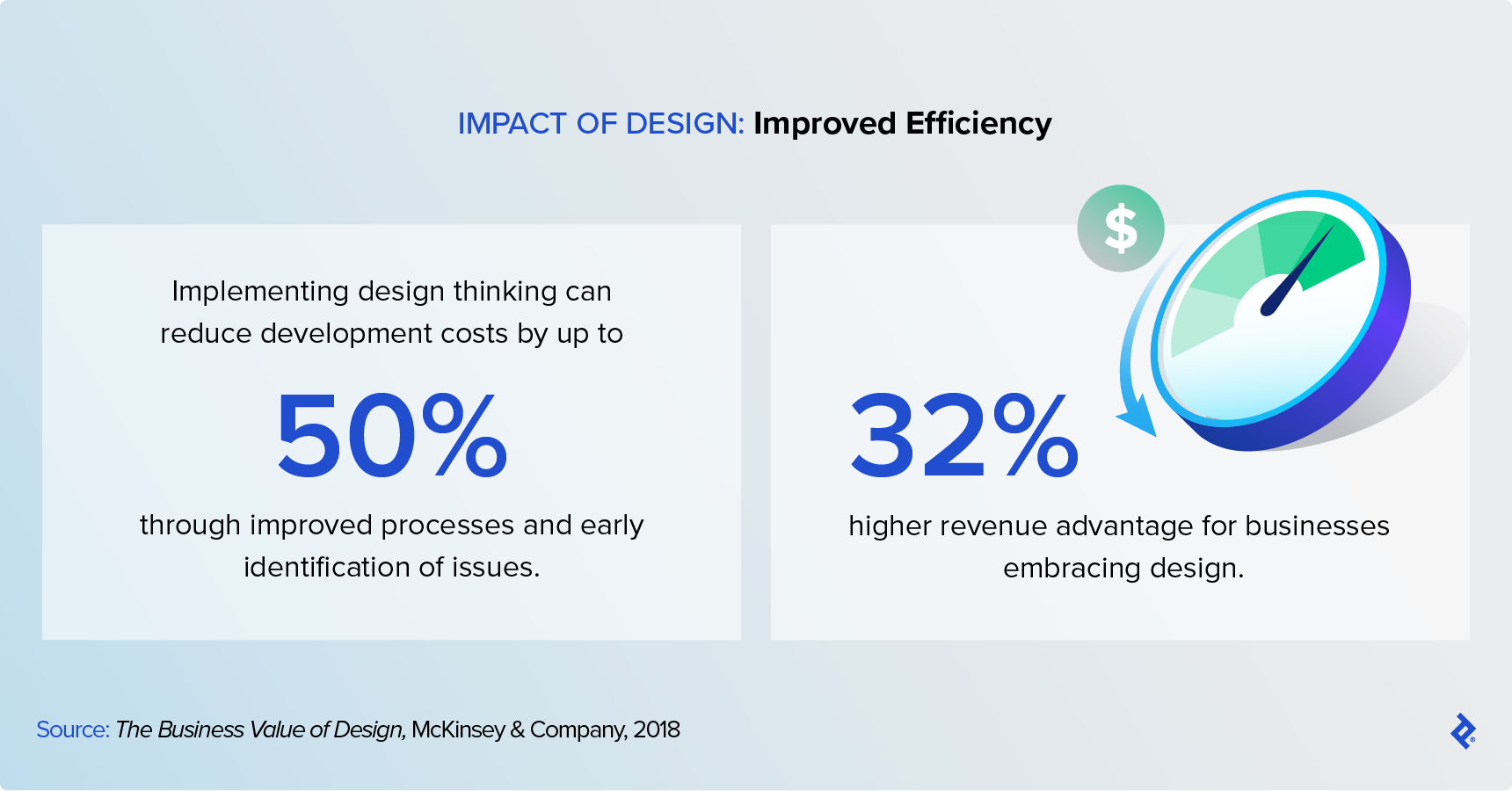The Value of Design on Your Bottom Line

Every business has a customer in mind for the product or service they bring to market. From an insurance company taking on the liability of potential future disasters on behalf of governments and citizens, to an agritech company providing efficient solutions for farmers, to an athleisure company serving up the latest moisture-wicking leggings for runners, all products and services should be created to meet the intended user’s needs.
Whether or not that product or service will ultimately meet their needs—while in the process maximizing returns and minimizing resources for the company—depends on one thing: how it was designed. Throughout my career, I have come across skeptics who do not believe in or see the value of design, especially if it requires upfront investment in capabilities that seem to lack pragmatism or structure.
I recently had a series of conversations with a client who was gearing up for a significant transformation. She needed to build a business case to support investing in design resources, a design system, and supporting infrastructure such as governance and decision-making processes, along with kicking off a pilot project in product design. Their biggest challenge? Internal stakeholders simply did not believe in design. I was, of course, more than happy to help them with a commercially sound case to strengthen their investment ask. (I’ll share how at the end of this article.)
My years as a customer experience officer (CXO), as a strategist at Booz & Company, and now as Toptal’s Digital Customer Experience Practice Lead have taught me that there is great commercial value in diving deep into human behavior—and fully understanding the human perspective. One of the most powerful ways to do that is with design thinking. In essence, design thinking is the intentional and strategic approach to solving the right problem with a solution that is desirable, feasible, and viable. In fact, many of today’s most successful product and service companies are built on it, including Netflix, GE Healthcare, and Uber Eats. And decades of research suggest that companies that employ design thinking have higher revenue, grow faster, and realize higher returns on investment (ROIs). A seminal 2018 McKinsey & Company study, which tracked more than 300 publicly listed companies for five years, found that businesses that invested more in design (measured by scores on the McKinsey Design Index) grew in some cases at twice the rate of their competitors.
Design thinking is not a luxury—it’s a strategic necessity that directly drives your bottom line; has a tangible impact on customer satisfaction, market differentiation, and profitability; and is the kind of thinking that can provide your company with a competitive advantage.
The Modern Definition of Design Thinking in Business
Design thinking is widely recognized as a customer-centered approach to problem-solving that involves empathizing with users, defining problems, ideating innovative solutions, prototyping, and testing. Tim Brown, Executive Chair of global design and innovation company IDEO, describes it as a discipline “that uses the designer’s sensibility and methods to match people’s needs with what is technologically feasible and what a viable business strategy can convert into customer value and market opportunity.” Harvard Business Review also highlights design thinking’s role in driving organizational innovation by focusing on understanding and solving users’ problems.

Whether you are a skeptic or someone who’s seeking to influence change and investment within your organization, let’s explore the potential value of design to your business by diving into the ways market-leading companies use it, and the direct impact it can have on your bottom line.
Ford vs. Netflix: How Design Drives Failure or Success
The classic cautionary tale about the risk of ignoring market research and user-centric design is the Ford Edsel, which failed spectacularly in the late 1950s. Despite spending 10 years and $250 million on planning one of Ford’s first brand-new cars in decades, the Edsel failed to resonate with consumers due to misaligned market predictions and inattentiveness to emerging compact car trends. This flop underscored the critical need for businesses to deeply understand consumer needs and market dynamics before launching new products.
The concept of design expanded during the mid-20th century to cover corporate identity and branding, as companies like IBM and Apple began to leverage design to differentiate themselves in the market. The digital revolution of the late 20th century brought a new layer of challenges and opportunities thanks to the emergence of UI and UX design, which underscored the importance of designing for audience needs and preferences in the digital realm. Netflix has become a household name in media consumption by employing design thinking in its UI, creating a highly personalized viewing experience. By not shying away from disrupting its own DVD delivery model in favor of streaming, investing early in streaming technology, and prioritizing customer experience (CX) across various devices, Netflix has revolutionized how media is consumed. The subscription video-on-demand service invests heavily in research to better understand the market, market trends, and its users. As a result, Netflix is considered a leader in interactive UI, AI-driven personalized recommendations, and dynamic high-quality thumbnails (which are now replicated across the majority of content platforms), all focusing on making the customer’s journey intuitive and engaging. Netflix did everything Blockbuster didn’t do.
Fast-forward to today, companies across sectors now recognize that design is a critical driver of innovation, customer satisfaction, and competitive advantage. This era has seen a shift toward service design, experience design, and system design, focusing on creating value for both the business and its customers. With the rise of technologies like AI and big data, design thinking is used to navigate complex business challenges, ensuring solutions are human-centric and technologically feasible. Moreover, there’s an increasing emphasis on sustainable and inclusive design, reflecting broader societal and environmental concerns.
For the Skeptics: Understanding the Case Against Design
Companies that aren’t sold on the importance of design thinking often come to regret their lack of upfront investment. Several years ago, I was leading a service design team that worked across various product lines as a shared resource. It was not a mandated capability, and product line executives could decide whether or not to leverage the team. (If you’re a Criminal Minds fan, essentially we had to be “invited in.”) One such initiative related to the development of a digital booking system. There were two user groups: customers and internal coordination staff. The company invested a fair amount into building the system, which technically worked incredibly well, but the internal coordination staff was soon overloaded by the time required to apply a new system to their already complex tech stack and address a sudden influx of customer complaints and queries.
At that point, my service design team was “invited in” to run a resource-heavy evaluation. Through conducting stakeholder interviews, analyzing complaints data, and reviewing the new experience against customer personas and needs hierarchies, we discovered that the vast majority of the customers were elderly and indicated no preference for digital channels. What’s more, the transaction volume was incredibly low and mostly one-off, meaning there would be a significant investment by customers to familiarize themselves with the new digital channel, only to transact once. Ultimately, the product met no customer needs and created an upswing in complaints, and therefore a demand for additional resources. My team recommended discontinuing the digital system, and the company leadership agreed.

This experience underscores the importance of involving service design early to truly understand user needs and avoid unnecessary solutions. So, why weren’t we invited in from the beginning? In order to fully understand the case against design—in other words, why a stakeholder (or perhaps you) would resist design thinking—we need to practice what we preach and understand user perspectives and needs. In order to educate or influence someone to adopt a new mindset, way of working, or process, it’s essential to be curious and open-minded enough to understand them and the biases, previous experiences, and thought patterns that influence their views.
Arguments against investing in design often revolve around its perceived high costs, unclear ROI, and the belief that design benefits are subjective and not directly linked to business outcomes. Skeptics might view design as a nonessential luxury rather than a strategic necessity and point to one (or more) of six common concerns as a reason not to leverage design thinking.
6 Design Fallacies
The cost of investing in design isn’t justified.
Concerns about initial investment costs often overlook the long-term value and ROI that strategic design brings, including market differentiation and customer loyalty. A finite amount of resources, including investment dollars, can drive someone to focus on known and tangible initiatives rather than long-term potential.
Design doesn’t directly impact the bottom line.
Skeptics often question the direct financial benefits of design, not recognizing that effective design improves UX, leading to increased sales and customer retention. They may not understand or see the link between design and these tangible outcomes.
The benefits of design can’t be quantifiably measured.
The challenge of measuring design’s quantitative impact can be addressed by tracking metrics such as customer engagement, conversion rates, and market share growth. One bad experience can lead to concerns that activities won’t be adequately measured in the future.
Design is about aesthetics, not functionality.
A common misconception is that design is purely cosmetic. In reality, it fundamentally shapes how users interact with products, enhancing both usability and satisfaction. Someone’s exposure to select aspects of the design process can lead to biases against the entire process.
It’s too difficult to find the expertise to implement design thinking effectively.
Doubts about internal capabilities to adopt design thinking can often be mitigated by training existing teams or through collaboration with external design experts. However, a lack of understanding can make someone less likely to support the process due to a fear of appearing uninformed or unskilled. If this is the case on your team, Toptal can embed on-demand design experts to fill those gaps.
It will take too long to see results.
A desire to see immediate results fails to acknowledge that design-driven transformations often lead to sustainable competitive advantages over time. This may stem from a focus on short-term results, sometimes linked to a person’s performance metrics.
How Design Directly Impacts a Business’s Bottom Line
Integrating design into business strategy is not merely about improving aesthetics; it’s about leveraging a systematic approach to innovation and problem-solving that puts human needs at the center. The business case for design is compelling, evidenced by both qualitative improvements in customer and employee experiences and quantifiable gains in efficiency, innovation, and revenue growth. There are myriad benefits of design thinking that directly impact the bottom line.
9 Benefits of Design Thinking
- Reduction in Development Costs: By focusing on research and prototyping, design can help identify potential issues early in the development process, reducing the need for costly revisions and late-stage changes.
- Operational Efficiency Gains: Streamlined processes and improved tools can reduce time spent on non-value-adding activities, lowering operational costs.
- Increased Customer Satisfaction and Loyalty: Enhanced experiences can lead to higher customer retention rates, more repeat business, and a greater likelihood of recommendations, directly impacting revenue.
- Market Differentiation: A strong, design-led brand identity can attract new customers and open up new markets, driving sales growth.
- Higher Success Rate for New Products: Leveraging design to validate concepts and refine offerings before full-scale development can increase the chances of market success.
- Faster Time to Market: Efficient design processes can accelerate product development cycles, allowing companies to capitalize on market opportunities more rapidly. Reducing the time it takes to release new products and features is a clear measure of development efficiency and agility—and it can mean more revenue faster.
- Customer Satisfaction (e.g., NPS, CSAT): Measurement indicators of customer satisfaction and loyalty can signal the effectiveness of CX enhancements.
- Operational Efficiency (e.g., process completion times, error rates): Redesigning internal processes can maximize efficiency.
- Revenue Growth and Market Share: Design aids in driving overall business outcomes, specifically commercially.

Design Thinking Use Cases by Industry
While some use cases for design thinking are universal (e.g., new product development, CX enhancement, and process redesign for efficiency), others are industry-specific. In my role at Toptal, I often use the following matrix to help clients explore top use cases by industry cluster, for a more nuanced approach to applying the value of design thinking.
|
Industry Cluster |
Top Use Cases for Design |
Top Value Drivers of Design |
|
Health and Life Sciences |
|
|
|
Communications, Media, Entertainment, and High-tech Devices |
|
|
|
Consumer Products and Services |
|
|
|
Industrial Products and Services |
|
|
|
Financial and Professional Services |
|
|
The Art and Science of Design Thinking in Business
While there are nuances in how design thinking is applied across industries and use cases, it clearly drives value to any business. Still, for the uninitiated, investing in design capabilities requires a leap of faith as the value is often proven after implementation.
Design thinking is both an art and a science, and as such requires a holistic view of business, innovation, and success. Design thinking calls on the creative, empathetic side of problem-solving, allowing businesses to explore innovative solutions that deeply resonate with users. This artistic aspect involves imagining the world from the customer’s perspective, crafting stories that speak to their needs, and visualizing solutions that enhance their experiences.
At the same time, design thinking is also grounded in a rigorous, methodical process. It involves iterating through cycles of prototyping and testing, leveraging data and insights to refine solutions. This scientific approach ensures that creative ideas are not just imaginative but also actionable and aligned with business goals.
Now, let’s revisit the client example I mentioned at the beginning. I helped them by putting together a point of view on design, very much similar to this article, which included benefit categories of design, how to calculate ROI, and real market examples. The client was then armed with the right information to influence their stakeholders. Ultimately, this will lead to an internal investment in design capabilities that will propel the business forward. If you are a skeptic of design thinking, I hope you have begun to understand the value that this process can bring to a business. If you’re already an advocate and want to drive cultural change in your organization, I hope you are now well equipped with the commercial proof points and real-life market examples that will influence your stakeholders.
Have a question for the Digital Customer Experience team? Get in touch.



